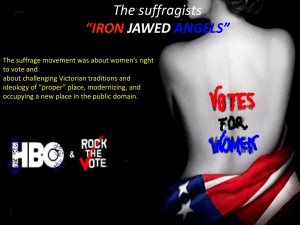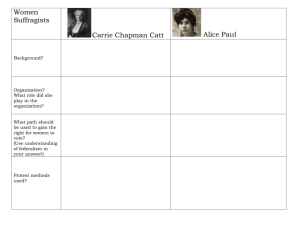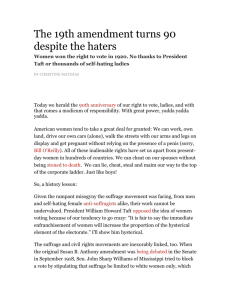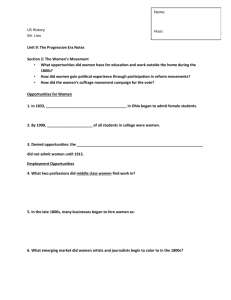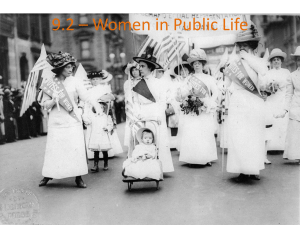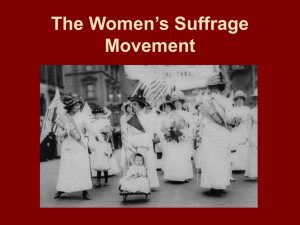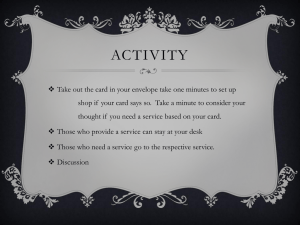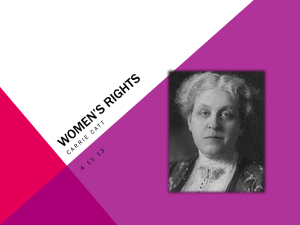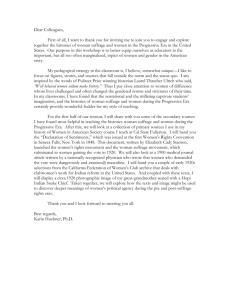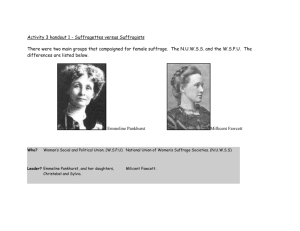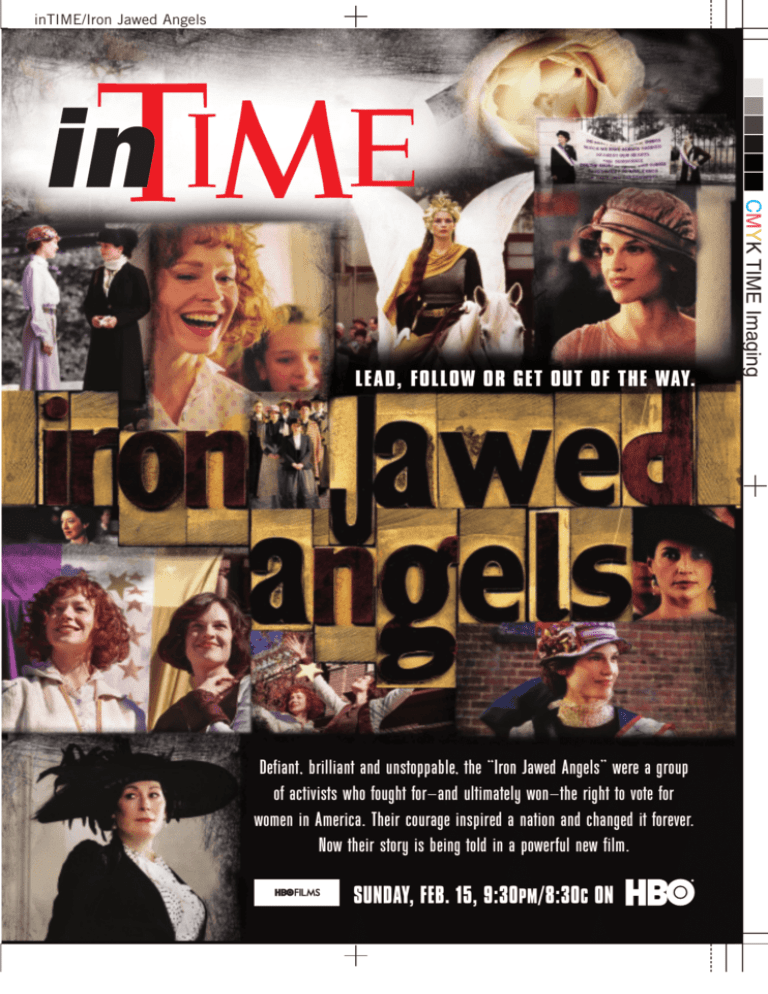
inTIME/Iron Jawed Angels
Defiant, brilliant and unstoppable, the “Iron Jawed Angels” were a group
of activists who fought for—and ultimately won—the right to vote for
women in America. Their courage inspired a nation and changed it forever.
Now their story is being told in a powerful new film.
SUNDAY, FEB. 15, 9:30PM/8:30C ON
CMYK TIME Imaging
LEAD, FOLLOW OR GET OUT OF THE WAY.
inTIME/Iron Jawed Angels
“
2
There will never
be a new world order
until women are a
part of it.
— A L I C E PA U L
LIBRARY OF CONGRESS
4
3
LIBRARY OF CONGRESS
CORBIS
5
BRYN MAWR COLLEGE LIBRARY
most picturesque figure in
the parade.
Leaders of the women
suffragists were much incensed because the police
did not make sufficient
provision for holding in
restraint the great throng
which hemmed in the
paraders. At a meeting held
at Memorial Continental
Hall the police of the District were denounced. A
resolution was adopted
calling for a Congressional
investigation and asking
Mr. Wilson to look into
what the suffragists called
“a disgraceful affair.” …
The procession, it was
charged, had not gone a
block before it had to halt.
Insults and jibes were shouted at women marchers, and
for more than an hour confusion reigned. The police,
the women say, did practically nothing, and finally soldiers and marines formed
a voluntary escort to clear
the way.
Mrs. Genevieve Stone,
wife of Representative Stone
of Illinois, said that a policeman had insulted her. This
policeman, she said, shouted: “If my wife were where
you are I’d break her head.”
FIGHTING FOR
DEMOCRACY:
The “silent sentinels”
outside the White
House in 1917 quoted
President Woodrow
Wilson, who had vowed
that America would
fight for democracy in
Europe. The suffragists
urged Wilson to extend
democracy at home
by supporting voting
rights for women.
POLITICAL PRISONERS:
The women who picketed the White
House in 1917 argued they had been
arrested not for any criminal acts,
but because of their political beliefs.
BETTMANN/CORBIS
1837 Kentucky grants
some women suffrage in
school elections.
LIBRARY OF CONGRESS
1848 The first women’s
rights convention is held
in Seneca Falls, New York,
in July.
1861 Kansas enters
the Union; the new
state grants women
the right to vote
in local school
elections.
1866 Elizabeth Cady
Stanton presents a petition
to Congress demanding
the vote for women.
1866
1820 Susan B. Anthony
is born on February 15 in
Adams, Massachusetts.
1842 Rhode Island
excludes Catholics and
urban males from voting.
LIBRARY OF CONGRESS
1791–1856 The 13 original and new states eliminate
property ownership as a
voting requirement.
1830s New York,
Connecticut and Pennsylvania enact new state
constitutions that make it
difficult or impossible for
free African-American men
to vote.
1848
dAtEs
★
3
CMYK TIME Imaging
”
CMYK TIME Imaging
inTIME/Iron Jawed Angels
ALICE PAUL 1885–1977
After two weeks of solitary
confinement…we decided upon
the hunger strike, as the ultimate
form of protest left us.
—A L I C E PAU L
“
”
suffrage pioneers Susan B. Anthony and Elizabeth Cady Stanton. A key
organizer for the National Woman’s Party, Burns was educated at Vassar
and Yale. After teaching English at Erasmus High School, she went to England to study at Oxford but soon abandoned a promising academic career
in linguistics in favor of political activism. Involved with the Pankhursts and
militant British suffragists, Burns was a paid organizer in Edinburgh
from 1910 to 1912. In 1913 she worked closely with Alice Paul to organize
the Woman Suffrage March in Washington, D.C., on the day before
Woodrow Wilson’s inauguration.
From 1915 to 1916 she edited The
Suffragist, a newspaper devoted
to women’s voting issues; in 1917,
along with Paul and numerous
other suffragists, she was sentenced
to the Occoquan Workhouse for
picketing the White House. Burns
embarked on a 19-day hunger
strike in November 1917; like Paul,
she was force-fed. In all, Burns
was arrested six times and spent
more time in jail than any other
American suffragist.
Alice Paul called her good friend Lucy Burns “a
thousand times more valiant than I.” The two were
considered the next-generation incarnation of
PICTURE HISTORY
LUCY BURNS 1879–1966
INEZ MILHOLLAND 1886–1916
A native of Brooklyn, New York, Inez Milholland was suspended from Vassar College after organizing a women’s
suffrage meeting in a cemetery to protest the college’s
refusal to allow suffrage speakers on campus. By the time
she graduated, Milholland had persuaded more than twothirds of her fellow students to support suffrage. She went
on to get a law degree at New York University after being
denied entrance on the basis of her gender by Harvard
and Columbia. On March 3, 1913—the day before Woodrow
Wilson’s inauguration—Milholland, draped in flowing white
robes and riding on a white horse, led a parade of an
LIBRARY OF CONGRESS
1869 Wyoming territory
grants suffrage to women.
LIBRARY OF CONGRESS
★
4
1869 Elizabeth Cady
Stanton and Susan B.
Anthony form the National
Woman
Suffrage
Association
(NWSA), whose
mission is to
secure voting
rights for women.
1869
1868 Elizabeth Cady
Stanton and Susan B.
Anthony launch the
feminist newspaper The
Revolution.
1872 Susan B.
Anthony is arrested
for trying to vote in
Rochester, NY.
ASSOCIATED PRESS
1870 Utah territory grants
full suffrage to women.
1874 In Minor v.
Happersett, the
U.S. Supreme Court
affirms that states
have the jurisdiction to decide
whether women are
allowed to vote.
BETTMANN/CORBIS
NEW JERSEY HISTORICAL SOCIETY
A brilliant organizer and activist, Alice Paul believed that women would
never be given the vote; they had to demand it. Born to a Quaker family
in New Jersey, she graduated from Swarthmore College and earned a
social-work degree in New York. In 1907, she traveled to England, where she
worked closely with the militant British suffragists Emmeline, Christobel and
Sylvia Pankhurst. Arrested several times
in London, Paul went on hunger strikes,
was force-fed and learned the value of
nonviolent civil disobedience to garner
publicity for her cause. Back in the U.S.,
she joined the National American Woman
Suffrage Association (NAWSA) in 1910
and was allowed to run their campaign in
Washington, D.C. As of 1916, 4 million
women in 12 states had the right to vote;
Paul wanted these women to “hold the
party in power responsible” by voting
against Democrat Woodrow Wilson in
the election of 1916. This strategy brought
Paul into intense conflict with NAWSA
President Carrie Chapman Catt, who
supported Wilson. In 1916, Paul founded
the National Woman’s Party, a radical
new suffrage group devoted to winning a universal
suffrage amendment to the Constitution instead of
working state by state. With the U.S. on the verge of
entering World War I in 1917, Paul set up a picket line at the White House—
the first in U.S. history—with signs that said 20 Million American Women
Are Not Self-Governed. Arrested on the trumped-up charge of
“obstructing traffic,” Paul was sent to the Occoquan Workhouse, where she
demanded to be treated as a political prisoner arrested for her beliefs, not
for committing a crime. When news of Paul’s brutal force-feeding during
a 22-day hunger strike reached the public, the White
House bowed to public pressure, and she was
released. Instrumental in bringing about ratification
of the 19th Amendment in 1920, Paul later went to law
school and wrote the first version of the Equal Rights
Amendment, presented to Congress in 1923. She
lobbied for women’s rights until her death in 1977.
inTIME/Iron Jawed Angels
estimated 5,000 suffragists carrying a banner that read Forward
Out of Darkness, Forward Into Light, later the motto of the
National Woman’s Party. This image became emblematic of the
fight for women’s rights in America. The marchers were attacked
verbally and physically but refused to give up. Milholland
became one of the leaders of the suffrage movement, speaking
across the country despite doctors’ warnings to stop in light of her
pernicious anemia. In 1916 she collapsed in the middle of a speech
in Los Angeles and died 10 weeks later at age 30. Some 10,000
people attended her memorial service, the first ever held for a
woman in the nation’s capital. Milholland’s last public words
were, “Mr. President, how long must women wait for liberty?”
CARRIE CHAPMAN CATT 1859–1947
1884 Belva Ann Lockwood
runs for President on the
National Equal Rights Party
ticket; she wins 4,149 votes
in six states.
1890–1910 Southern
states enact voter
restrictions, upheld by
the United States
Supreme Court, that
deny voting rights
to approximately 90%
of all African-American
voters.
To learn more about suffrage history, log on to
www.timeclassroom.com/voting. For more on the making of
Iron Jawed Angels, visit www.hbo.com/films/ironjawedangels.
LIBRARY OF CONGRESS
1878 The first
women’s suffrage
amendment is
presented in the
United States
Senate.
1882 The Senate and
House establish committees
to study women’s suffrage.
”
BETTMANN/CORBIS
IDA WELLS-BARNETT 1862–1931
1876 At the United States
centennial celebration in
Philadelphia, Susan B.
Anthony and the NWSA
present a declaration of
women’s rights.
Referred to as “the Napoleon of the Women’s
Rights Movement” and the “Moses of her
sex,” Susan B. Anthony was a pioneer in the
—S U SA N B . A N T H O N Y
suffrage movement. Raised in a Quaker
abolitionist family, Anthony taught in upstate New York; she became
involved in the temperance movement and worked for the American
Anti-Slavery Association. After 1852, she teamed up with her friend Elizabeth Cady Stanton and worked on behalf of women’s rights, later publishing
the weekly Revolution, a radical women’s paper calling for suffrage,
equal education and employment opportunities, and trade unions for women. Never
married, she had a keen awareness of the
need for women to be financially independent and lobbied for equal pay for
women. In 1869, Anthony and Stanton
founded the National Woman Suffrage
Association. Anthony was arrested in
1872 for taking women to the polls in her
hometown of Rochester, New York, and
again in 1873, when she tried to vote herself.
As president of NWSA from 1892 to 1900, she
led the crusade for a federal women’s suffrage
amendment. In 1979, the U.S. Treasury
honored her many achievements by issuing
a one-dollar coin in her name.
Failure is impossible
Ida Wells-Barnett was a crusading journalist, women’s advocate and cofounder of the National Association for the Advancement of Colored People
(NAACP). The daughter of slaves, she taught in Mississippi and Tennessee
1876
UNIVERSITY OF CHICAGO
“
SUSAN B. ANTHONY
1820–1906
1890 Wyoming enters the
Union; it becomes the first
state in which women have
the right to vote.
1890 The National
American Woman Suffrage
Association (NAWSA)
forms from the
merger of other
suffrage groups.
1890
Born in Wisconsin, Carrie Chapman Catt worked tirelessly on behalf of suffrage for women. She became a high school principal in
Iowa in 1881 and was appointed one of the
first female superintendents in the country
in 1883. When she married engineer
George W. Catt in 1890, the couple had an
unusual prenuptial agreement, stipulating that Catt would have four
months per year to pursue suffrage. In 1902 she founded the International
Woman Suffrage Association and served as its honorary president until 1923.
She headed the New York suffrage movement, organizing two campaigns
that won the state vote for women in 1917. During that time, she reorganized NAWSA and became its president in 1915. Catt’s strategy involved working at both the federal and state levels; she
developed a membership system, study
courses and organizing manuals for
NAWSA. On good terms with President
Wilson, Catt clashed with Alice Paul, who
urged women to vote against Wilson in 1916
because he had failed to support suffrage.
After the 19th Amendment was adopted,
Catt reconstituted NAWSA as the League of
Women voters, with 2 million members.
She appeared on the cover of Time in 1926.
CMYK TIME Imaging
and authored one of the first accounts of a
lynching, publicizing the issue and running
anti-lynching campaigns throughout the
1890s. In 1913 she founded the first black
women’s suffrage group, the Alpha Suffrage
Club of Chicago. That same year, she challenged NAWSA’s leaders—who had failed
to take a stand against racial segregation—by
marching with the Illinois delegation, rather
than at the back, of the Washington, D.C.,
suffrage parade. Her autobiography, Crusade for Justice, was published in 1928.
★
5
CMYK TIME Imaging
inTIME/Iron Jawed Angels
W
LIBRARY OF CONGRESS
hen they set out to tell the story of Alice Paul and her
colleagues, the filmmakers who created Iron Jawed Angels
knew that many Americans weren’t aware of this chapter
in U.S. history. Determined to capture both the power and drama
of the suffrage movement, the film’s writers interviewed historians,
delved into newspapers and studied archival photographs. The
images on this page show how the writers, costume designers and
actors brought suffrage history to life.
DEMMIE TODD/HBO
RIDING FOR LIBERTY: Inez Milholland, known as the “woman
on the horse,” led the 1913 suffrage parade (above), in which thousands of women marched through the streets of Washington, D.C.,
to dramatize their desire to vote. In Iron Jawed Angels, Inez Milholland
(played by Julia Ormond, left) rides a white horse and wears wings.
The wings are a reference to the angel figure that suffragists often
incorporated in their imagery, representing an idealized vision of
Justice and Liberty.
DEMMIE TODD/HBO
RADICAL TACTICS: In 1917,
suffragists set up a daily picket
line outside the White House—a
first in American history. They
continued even after the nation
entered World War I and, as a
result, were accused of being traitors. In one of their most radical
statements, the women referred
to President Wilson as “Kaiser.”
The “Kaiser Wilson” banner (right)
was recreated word for word in
Iron Jawed Angels (far right).
NATIONAL ARCHIVES
LIBRARY OF CONGRESS
★
6
1913 An estimated 5,000
women stage a parade in
Washington, D.C., to lobby
for suffrage; riots break
out when police fail to
control crowds.
1917 National
Woman’s Party
stations daily pickets
at the White House
in civil disobedience campaign.
1916 Alice Paul and Lucy
Burns found the National
Woman’s Party (NWP).
1916
1911 The National Association Opposed to Woman
Suffrage is founded.
1916 Jeannette Rankin of
Montana becomes the first
woman elected to the U.S.
House of Representatives.
She serves until 1919 and is
re-elected in 1940.
LIBRARY OF CONGRESS
1908 National Women’s
Day is celebrated in the
U.S. for the first time;
the celebration goes
international in 1910.
1912 Theodore
Roosevelt's Progressive
Party becomes the first
national political party to
support suffrage for
women.
inTIME/Iron Jawed Angels
What aspects of Alice Paul do you admire most?
She was someone who believed very strongly in the right of all
H
human beings, of all citizens, to have a voice. She found something that she believed in, and she followed it with every cell of her
body and every cell of her brain. Everyone in this world knows what
it’s like to have a passion or to have a dream, and to face tremendous
odds against realizing that dream. Alice Paul’s diligence and her
unyielding determination were a real inspiration to me.
CMYK TIME Imaging
★
Can you talk about the sacrifices that Alice Paul made?
I don’t know if I could sacrifice as much as she did. She sacriH
ficed having a husband, and having children, because she felt
that every piece of her had to be devoted to this cause. The sacrifices
that Alice Paul made were huge. I don’t know if I could do that.
DEMMIE TODD/HBO
★
B
est known for her Academy Award-winning performance in
Boys Don’t Cry, 29-year-old Hilary Swank (above right) plays
Alice Paul in Iron Jawed Angels. A native of Washington State,
Swank appeared in her first play when she was nine. As a teenager,
she swam competitively in the Junior Olympics and Washington
State championships; she ranked fifth in the state in all-around
gymnastics. Swank spoke with inTIME about
Alice Paul, the suffrage movement and the
making of Iron Jawed Angels, which premieres
Sunday, February 15, 2004 on HBO.
What are your thoughts on the film’s style, and in particular
on the mix of historical and contemporary elements?
All along, Katja von Garnier, our director, was very intent on
H
staying true to the historical facts. She felt the importance of
that; this is, after all, a true story. But it was also Katja’s intent to make
a movie where you weren’t sitting back and watching a history lesson.
She wanted viewers to feel, “Wow. That could have been me.” Even
though these women were living in the early
1900s, they had the same desires and passions
and needs as we do now. So she took the liberty
of using contemporary music, including songs
by Sarah McLachlan. It’s really fresh, really
entertaining. This is a movie about history, but
there’s nothing dry about it.
★
The sacrifices
“
that Alice Paul
How much did you know about Alice Paul
before you got involved in this project?
Sadly, I didn’t know much about Alice
H
Paul. I knew that there was a suffrage
movement, but I didn’t really understand what
the women who were part of it had gone through.
When I read the script, I was riveted. Here
was a true story about a group of remarkable women who paved the way for me
and for all women living in 21st-century
America. For a very long time—as the film
makes clear—women were third-class
citizens in this country. I can’t imagine not
being able to have a voice within my government. But 100 years ago, women did
not have the right to vote in America.
That is absolutely amazing to me.
★
made were huge.
I don’t know if I
could do that.
”
— H I L A RY SWA N K
What message do you hope high school
students take away from this film?
No matter how old you are or how
H
young you are, there will be obstacles all the way along in life. We all have
our doubts; there were times when Alice
Paul doubted herself. And there were
certainly times during the filming when I
said, “Oh, God, this is so hard.” But I think
if people really believe in themselves, they
can bring about change. I hope students
will be inspired to listen to themselves,
and to believe that every one of us has the
power to make a difference.
★
DEMMIE TODD/HBO
BRUCE DAVIDSON/MAGNUM PHOTOS
1918 Suffrage Amendment passes
United States
House by exactly
a two-thirds vote;
it loses by two
votes in the
Senate.
1920 Tennessee becomes
the 36th state to ratify the
19th Amendment when
State Senator Harry Burn, 24,
casts the deciding vote. The
Amendment becomes law
on August 26, guaranteeing
all U.S. women the vote.
1972 Shirley Chisholm
becomes the first AfricanAmerican woman to seek
the Democratic nomination for President.
1965 The Voting Rights
Act, designed to counter
racially discriminatory voting
practices, becomes law.
1971 The 26th Amendment
lowers the voting age to 18.
1972
1919 The House votes 304
to 90 to pass the 19th Amendment; the Senate approves it
56 to 25. It is sent to the states.
1918
1918 Reversing his position, President Woodrow
Wilson endorses women’s
suffrage as a war measure.
1984 Geraldine
Ferraro, a Democrat from New
York, becomes
the first woman
to run for Vice
President.
★
7
THE CLEVELAND LEADER
CMYK TIME Imaging
inTIME/Iron Jawed Angels
CONFRONTING A PRESIDENT: To protest
Woodrow Wilson’s refusal to push for a Constitutional
amendment backing suffrage, suffragists staged a
daily picket line at the White House beginning in January 1917. Wilson was initially bemused by the “silent
sentinels”; as this 1917 cartoon illustrates, he often
walked past them and even invited them in for coffee
(they declined). Once the U.S. entered World War I,
though, the White House came to view the protesters
as a serious embarrassment and had them arrested
on the trumped-up charge of “obstructing traffic.”
■ No suffrage for women
until ratification of the
19th Amendment in 1920
■ Partial women’s suffrage before 1920
■ Full women’s suffrage before 1920,
with date granted
Before the 19th Amendment was ratified in the U.S. in 1920,
women already had the right to vote in these countries:
New Zealand . . . . 1893
Australia . . . . . . . . 1902
Finland. . . . . . . . . . 1906
Denmark . . . . . . . . 1915
Mexico. . . . . . . . . . . 1917
Russia . . . . . . . . . . . 1917
England . . . . . . . . . 1918
Ireland. . . . . . . . . . . 1918
Scotland . . . . . . . . 1918
Germany . . . . . . . . 1918
Hungary . . . . . . . . . 1918
Canada . . . . . . . . . .1918
g E t In v OLv Ed !
I
n 2000, 8.6 million eligible 18- to 24-year-olds voted—but 15
million didn’t. If you’re 18 or older, you can help keep the spirit of
Alice Paul alive by making your vote count in the 2004 election! And
if you’re under 18, there are still plenty of ways to get involved in the
political process. One great resource is Rock the Vote, the nonpartisan
group that joins entertainment and politics to register and mobilize
young people to vote. With the help of musicians, actors and athletes,
Rock the Vote Street Team members make politics hip for the new generation of voters. Another resource to check out is Youth Vote Coalition,
a national nonpartisan coalition of diverse organizations dedicated to
increasing political and civic participation among young people. To
learn more and register to vote online, visit www.rockthevote.com or
www.youthvote.org
VerbAtim
We are being imprisoned not because we
“
obstructed traffic, but because we pointed
out to the President the fact that he was
obstructing the cause of democracy at home,
while Americans were fighting for it
abroad.
—ALICE PAUL, 1917
”
be regarded as women.”
“They cannot
—PHILADELPHIA INQUIRER, in a 1917 editorial
denouncing the women who picketed the White House
“
I’ve just had the most revolting experience
possible. I’ve been forcibly fed, and I feel that
every atom of American self-respect within
me has been outraged…Dr. Ladd appeared
with a tube that looked like a hose, and a pint
of milk in which two eggs had been stirred up.
Without any heart exam, he put the tube in my
mouth and…poured the liquid rapidly down
the tube…I gagged and choked terribly.
”
—ELIZABETH McSHANE,
Philadelphia businesswoman and one of 168 women
imprisoned after being arrested in suffrage protests
held between 1917 and 1919
“
The way to reform has always led through
prison.
—EMMELINE PANKHURST,
”
British suffragist, 1914
The right of the citizens of the United States
“
to vote shall not be denied or abridged by
★
8
Copyright ©2003 Time Inc. inTime is a trademark of Time Inc. Published in association
with HBO. Printed in the U.S.A. Iron Jawed Angels artwork ©2003 Home Box Office,
Inc. All rights reserved. HBO® is a service mark of Home Box Office, Inc.
the United States or by any state on account
of sex.
—TEXT OF 19th AMENDMENT, 1920
”

